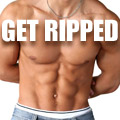Q&A with Mike Furci
11/27/2005
Furci Home / Fitness Channel / Bullz-Eye Home
Q: Hi Mike,
I'm a 17-year-old male, 6'0, 143 lbs. I've been weight training for three years using your methods. With amazing results, I might add. But I feel like I don't have a large base to put the muscle on (being 143 lbs. an' all), although I have the physique that I like. I was wondering if there was any way that I would be able to gain some weight without possibly injuring myself or stopping my training.
Also, I blew out my shoulder while benching a little while back (probably a year or so) and I've lost some shoulder strength. It still hurts when I warm up and do, for instance, lateral raises. I also cannot exceed 20 lbs with lateral raises. Is there a way to help with this?
Any help would be greatly appreciated.
Matt
A: Matt,
I would be happy to help you out, but I am hesitant to do so without finding out what is going on with your shoulder. It sounds like you have an impingement problem, which is an injury very common to athletes and people who weight train. If this is the case, your rotator cuff, specifically the supraspinatus, is injured and inflamed. The first thing I'd suggest is to see a doctor about the problem.
Unfortunately, this can be a nagging and sometimes debilitating injury. Your doctor will tell you that the best thing you can do for this is to get the inflammation down to facilitate the healing process. This can be done by icing your shoulder multiple times per day for an average of 20 minutes per application. Also, you can use an NSAID like Ibuprofen or Naproxen sodium, but talk to your doctor and, given your age, your parents about that. If you choose to use an anti-inflammatory, because of your age, consult your parents.
If and when your doctor clears you for activity, there are some movements I would like you to perform twice per week. Read my article "Exercise of the Month - External Rotation." Use light weight and perform two sets per exercise, doing between 15 and 20 reps per set. If the pain does not start to subside after a couple weeks you will need to see an orthopedic surgeon, preferably one that specializes in shoulder injuries.
Good luck,
Mike
Q: My son isn't lactose intolerant; he simply is allergic to milk. Since my wife and I found out about his various food allergies, we've been giving him soy milk with his cereal and in foods that require dairy milk for cooking. My question is based on your quote of, "Some of the various soy products contained in foods include: soy oil, soy protein, and soy lecithin. Many recent studies substantiate the more soy consumed, the lower the testosterone levels go. And to top it off, many of the products we use are packaged in plastic containers which also supply us with ecoestrogens, which mimic hormonal estrogen when consumed by humans. Unfortunately, these estrogen-like substances have other deleterious effects." Do I, as red-blooded-American father who wants his
son to reach his full potential, have anything to worry about? And if I do, how can I supplement my son with the proper foods so he can have regular levels of testosterone?
Thanks,
Johnny
A: STOP feeding your kid soy immediately! Yes, you do have something to worry about when it comes to phytoestrogens and ecoestrogens. Before you feed your child more soy products, read "The Whole Soy Story" and "The Untold Story of Milk." Pasteurized and homogenized milk is denatured and is linked to many illnesses. Remember that all milk allergies are found in studies using pasteurized/homogenized milk. Does he have the same problems with cheese products? If you have access, I would try to buy whole raw milk products from grass fed cows. Whole raw milk has been shown time and time again to be beneficial to people with allergies and is loaded with nutrients unlike the pasteurized garbage we buy in grocery stores. You can find lists of farms on the internet. If you can’t acquire whole milk, or you just don’t want to use it, try protein powders.
The only problem with protein powders is their lack of A and D vitamins, calcium and other nutrients contained in whole milk. My favorite powder is Metabolic Drive. It's of the highest quality and he'll like the flavor. I often add it to water to use on cereal.
I would also like you to visit westonaprice.com. This site is loaded with nutritional information that I think would be beneficial to anyone.
Mike
Q: Hey Mike,
I have a quick question. I'm about to start buying powdered protein, and I read that you recommended Metabolic Drive. I was checking it out and noticed in the nutritional facts that it contains or is made with soy. I know you're not very keen on soy, and I trust that you know what you're talking about. So what's the deal with Metabolic Drive? Should I be careful of the soy in it or not worry about it?
Thanks,
Jake
A: I was concerned about this when they came out with Metabolic Drive, formerly Low Carb Grow, a few years back. It is listed as an allergen warning but not in the ingredient list. It is a miniscule portion of protein found in soy for flavoring. By law it still must be listed. There are no negative side effects.
Now, proteins that have soy in their ingredients list should be avoided.
Q: Hey Mike,
I need advice on how to lose a gut once and for all. I run plenty (2-4mi), I watch what I eat, and I lift between running days. With school taking priority, my workout routine can hit highs and lows and I may go three weeks without consistent workouts. My goal is to achieve the tapered broad shoulder/flat stomach look so I do a lot of shoulder and chest workouts; however, my stubborn gut is hindering progress toward this goal. I've heeded all the advice on proper diet and exercise but nothing seems to work. I am more than ready to put in the work, but it's disheartening when work doesn't equal results. Any tips on how to attack this challenge?
Thanks,
Ron
A: Ron, yours is an all too familiar plight. Send me a sample of an average day's diet...and DON’T LIE. Also, send me your workout routine.
Ron wrote back very quickly and I answered within his email. I posted it the way I answered because I thought it would better for readers to compare what he currently does with my advice.
Q: Mike,
Diet:
Breakfast -- the usual cereal, bagel, waffle, or omelet with juice or milk (probably the most skipped meal though; when I don't have time for a full breakfast I usually eat a fruit yogurt cup with a glass of juice or an Ensure/Boost nutrition drink).
Lunch -- spaghetti with veggie/turkey sandwich, or chicken with veggie stir-fry, something along the lines of a helping of meat and a sandwich.
Dinner -- similar to lunch; a serving of meat with a sandwich or some stir-fry. My diet is pretty basic with average intake of meats, vegetables and sandwiches. I snack on Wheat Thins or Sun Chips occasionally, but mostly stay away from chips, candy, Starbucks, fried foods, etc. I stay away from fast food as much as possible. I may slip maybe once or twice a month (Subway or Taco Bell).
A: Although you may think you're eating a clean, healthy diet, you are not. Your diet is loaded with carbohydrates, mainly simple sugars. If you keep eating this way, you will never get a leaner physique. This is not your fault. Like most Americans, you've been fooled by the food industry into thinking the foods you listed are healthy, even though you are making a concerted effort to eat "right".
Let's get right to the point.
Breakfast: Bagels, waffles, Esure/Boost, fruit cups and almost all cereals are out. The only cereal I recommend is oatmeal or Fiber One. All that other crap can be eaten once in a great while, but to be eaten regularly will halt your progress because they’ll spike your insulin levels. The higher your insulin levels, the less fat you burn as fuel. Juices are also out. They are barely better than drinking soda pop and also raise insulin levels. Eggs, meats and protein powders are all good for breakfast. I usually put my protein in my oatmeal.
Lunch and dinner: If you want spaghetti, use the low carb variety. Dreamfields is excellent, but it’s better to skip spaghetti and use whole grain rice.
Stop snacking on Wheat Thins or anything like it and never eat a carbohydrate without eating some protein with it. Eat low-fat cottage cheese or other small meals as a snack.
My workout routine (3-5days/week): I work certain muscle groups each workout. Varying number of sets for each group, and reps remain between 6-10, unless I drop the weight which increases the reps to 12-15.
Day 1: Chest (sets of flys [3 sets on flat bench, 2 or 3 at 45 degree angle, 2 on a negative slope bench]), shoulder (3 sets of regular barbell shoulder press, 2 sets of decreased weight/increased rep on Hammer Strength shoulder machine), back (3 sets of lat pull down, 2 sets of Hammer Strength machine).
Are you doing all these sets to failure? If you are, you are doing way too many sets. If the sets you have listed are warm-ups leading to a working set, you're okay. Forget about decline bench anything. Stick to flat or incline, no more than 30 degrees. The higher the incline, the more shoulder you use and it doesn't affect your chest any differently. Cut out the shoulder barbell press; you don't need it. Start out with dumbbell lateral raises. Conclude your shoulder workout with seated dumbbell presses. Instead of doing triceps on day 2, move them to day 1. Push-downs with a straight short bar concluding with extensions is fine.
Day 2: Bicep (3 sets regular bicep curls, 2-3 sets of concentrated bicep curls on 45 degree angle bench). Triceps (3 sets of regular tri pull downs with rope or bar, 2-3 sets extending barbell over my head)
Start day 2 with back. Close grip pull-downs with "V" bar. The palms of your hands will face each other. End with bent-over barbell rows or Hammer Strength if its a row.
Day 3: Run (2-4mi) on treadmill. Ab work afterward: sit-ups on stability ball, 3 sets of 15. At times I may do a quick lift session (30 min) of increased weight/lower reps (about 5reps) before a run. Usually a short chest/shoulder, or bicep/triceps routine.
I may not follow the workout schedule exactly. I may run three days out of the week and only lift one or two (in this case I usually do a short lift session before a run). Others, I may only run two and lift two to three. It is pretty much dictated by the time available.
The workouts I prescribed above are to be done once a week. There is no need to do them more. And never, ever sacrifice weight training for cardio. Weight training will do far more for muscle gains and fat loss. Cardio will not preserve, much less increase, lean tissue. Nobody, and I mean nobody, is too busy to get two to three weight training sessions in per week. It takes a little motivation and discipline.
That's pretty much my routine in a nutshell. Any other tips would be greatly appreciated.
Thanks,
Ron
Got a question for Mike? Send it to mike@bullz-eye.com.
You can follow us on Twitter and Facebook for content updates. Also, sign up for our email list for weekly updates and check us out on Google+ as well.







